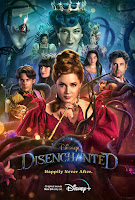Peter Gray started his review by saying, “With Hocus Pocus 2
proving a sizeable success, The Princess Diaries 3 now officially in
the works, and both Jamie Lee Curtis and Lindsay Lohan discussing their
interest in a Freaky Friday sequel, the House of Mouse is more than
proving itself in the business of revisiting original titles for the sake of
nostalgia, fan demand, monetary possibilities, or a combination of all of the
above.”
Joining the list is “Enchanted.”
Gray said, “15 years on from Kevin Lima’s
expectation-exceeding musical comedy – the very one that arguably catapulted
Amy Adams to global stardom – Disenchanted comes along to dispel the fairy-tale
cliché of “Happy ever after”, and present its forever-optimistic princess
Giselle (Adams, effortlessly slipping back into the character) in a life
removed from the magic of both her homeland and her newfound oasis;
respectively, the animated land of Andalasia and the concrete jungle of New
York City.”
Gray continued, “Whilst much of the appeal of
Enchanted was that Giselle, the perfect encapsulation of a goodie-two-shoes
princess, was a fish-out-of-water in a big city.” It makes sense that
screenwriter Brigitte Hales would look at the story of what comes after
happily ever after. Gray mentioned, “The reality isn’t nearly as appealing for
a Disney audience though (or Disney+ in this case), so Giselle, silver fox beau
Robert (Patrick Dempsey, not looking entirely engaged throughout), their young
baby daughter, and Robert’s now-teenaged daughter Morgan (Gabriella
Baldacchino, replacing Rachel Covey from the original) uproot their Manhattan
digs for a fresh start in Monroeville, a fictional town that appeals to
Giselle’s eye due to its seeming fairy-tale aesthetic.”
Moving into a larger home that’s in need of a good
repair – nothing a little song-and-dance won’t fix – and immediately starting on
the backfoot when it comes to Monroeville’s queen bee Malvina, played by Maya
Rudolph (enjoying eating the scenery), Giselle is worried the fairy-tale she
wanted is more a nightmare. Isn’t just her day then that Giselle’s former prince
lover, now king, Edward (James Marsden) and his bride, Nancy (Idina Menzel,
thankfully given the chance to let out a tune this time), come for a visit and
bring a magical wishing wand as a gift. Do you think that the wishing wand will
seriously be a part of this story?
Wanting a fairy-tale land resembling Andalasia means
Giselle’s wish turns Monroeville into a fairy-tale land, turning Malvina into
the traditional evil queen of the Maleficent type, and Giselle into the evil
stepmother she’s always made sure she never became. This decision to put two
villainesses against each other is full of possibilities, and Adams is having a
lot of fun when she leans into the eviler side of Giselle – her movements and
vocal pattern change instantly – but this story only ever feels half-done, with
“Disenchanted” apparently too focused on its song numbers.
Gray noted, “Whereas the first film only lightly
peppered musical numbers to enhance its magical elements, Disenchanted is
practically a full-blown musical of sorts, churning out nearly a dozen songs
over the course of its 118 minutes; none of which prove remotely
memorable. Longing for the absolute joy
that was such a number as the first film’s Central Park ditty :That’s How You
Know”, the closest Disenchanted comes to any type of magic is in the campy
battle of who’s more evil of Giselle and Malvina when they duet on “Badder”, a
midway set-piece that truly livens up a sequel that’s arrived a few years too
late.”
Despite there being a type of joy held when watching “Disenchanted”
because of how precious Amy Adams is in her role, and films such as this is
there to simply entertain on the safest area are always welcome feed for
parents wondering what to let their children watch, it’s that Adam Shankman’s film
fails to leave an impact that truly becomes a disappointment. The magic in
happily ever after is nowhere to be found here. This makes it, literally, disenchanting.
As you may have thought, this film is not as good as
the first one. I had heard rumors of this sequel for a long time, and it kept
getting delayed because of the pandemic, and I feel they could have worked on
this film to make it better. This is just a stereotypical Disney trope sequel
that is not as good. Check it out if you want, but you will not like it
compared to the first one. At least it is on Disney+, so you don’t have to
worry about wasting your money.
Thank you for joining in on my review today. Look out
next month to see what I will end the year off with.








